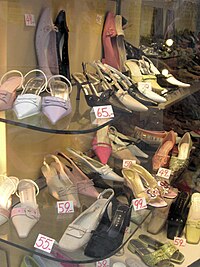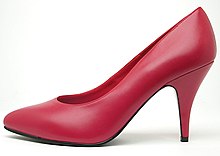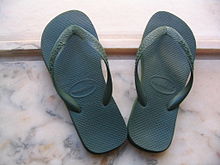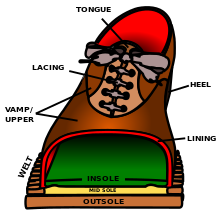- Shoehorn: can be used to insert a foot into a shoe by keeping the shoe open and providing a smooth surface for the foot to slide upon.
- Shoe tree: placed inside the shoe when user is not wearing it, to help maintain the shoe's shape.
- Heel grip: used to prevent the shoe from slipping on the heel if the fit is not perfect
- Foam tap: a small foam pad placed under the ball of the foot to push the foot up and back if the shoe is too loose.
- Shoe polishing equipment:
- Shoe polish: a waxy material spread on shoes to improve appearance and glossiness, and provide protection.
- Shoe brush and polishing cloth: used to apply polish to shoes.
- Overshoes or galoshes: a rubber covering placed over shoes for rain and snow protection.
- (Orthopedic) shoe insert: insert of various materials for cushioning, improved fit, or reduced abrasion. These include padding and inner linings. Inserts may also be used to correct foot problems.
- Shoe bag: a bag that protects shoes against damage when they are not being worn.
- Shoe stretcher: a tool for making a shoe longer or wider or for reducing discomfort in areas of a shoe.
- Snow shoe: a wooden or leather piece which increases the area of ground covered by the shoe.
- Shoelaces: a system used to secure shoes.
Types
Dress and casual
Dress shoes are characterized by smooth and supple leather uppers, leather soles, and narrow sleek figure. Casual shoes are characterized by sturdy leather uppers, non-leather outsoles, and wide profile.
Some designs of dress shoes can be worn by either gender. The majority of dress shoes have an upper covering, commonly made of leather, enclosing most of the lower foot, but not covering the ankles. This upper part of the shoe is often made without apertures or openings, but may also be made with openings or even itself consist of a series of straps, e.g. an open toe featured in women's shoes. Shoes with uppers made high to cover the ankles are also available; a shoe with the upper rising above the ankle is usually considered a boot but certain styles may be referred to as high-topped shoes or high-tops. Usually, a high-topped shoe is secured by laces or zippers, although some styles have elastic inserts to ease slipping the shoe on.
Men's
Men's shoes can be categorized by how they are closed:
- Oxfords (also referred as "Balmorals"): the vamp has a V-shaped slit to which the laces are attached; also known as "closed lacing". The word "Oxford" is sometimes used by American clothing companies to market shoes that are not Balmorals, such as Blüchers.
- Blüchers (American), Derbys (British): the laces are tied to two pieces of leather independently attached to the vamp; also known as "open lacing" and is a step down in dressiness.
- Monk-straps: a buckle and strap instead of lacing
- Slip-ons: There are no lacings or fastenings. The popular loafers are part of this category, as well as less popular styles, such as elastic-sided shoes.
Men's shoes can also be decorated in various ways:
- Plain-toes: have a sleek appearance and no extra decorations on the vamp.
- Cap-toes: has an extra layer of leather that "caps" the toe. This is possibly the most popular decoration.
- Brogues (American: wing-tips): The toe of the shoe is covered with a perforated panel, the wing-tip, which extends down either side of the shoe. Brogues can be found in both balmoral and blucher styles, but are considered slightly less formal.
Formal high-end men's shoes are manufactured by several companies around the world, most notably in England, France, Italy, and America. Notable British brands include: Church's English Shoes (est. 1873), John Lobb Bootmaker (est. 1849), Edward Green Shoes (est. 1890), and Crockett & Jones (est. 1879). Both John Lobb and Edward Green offer bespoke products. In between the world wars, men's footware received significant innovation and design, led by cobblers and cordwainers in London's West End. The most notable French product is made by J.M. Weston. Armani of Italy was a major influence on men's shoe design in the 1960s-1980s until they returned to the larger proportions of its forebears, the welt-constructed Anglo-American dress shoe originally created in Edwardian England. Another well-known Italian company isSalvatore Ferragamo Italia S.p.A.. The remaining elite American companies are Allen Edmonds and Alden Shoe Company. Alden, located in New England, specializes in genuine shell cordovan leather from the only remaining horse tannery in America (Chicago) and is completely manufactured in America, whereas Allen Edmonds, of Wisconsin, is a larger company that outsources some of its production.
Women's
There is a large variety of shoes available for women, in addition to most of the men's styles being more accepted as unisex. Some broad categories are:
- High-heeled footwear is footwear that raises the heels, typically 2 inches (5 cm) or more above the toes, commonly worn by women for formal occasions or social outings. Variants include kitten heels (typically 1½-2 inches high) and stilletto heels (with a very narrow heel post) and wedge heels (with a wedge-shaped sole rather than a heel post).
- Sneaker boot or sneaker pump: a shoe that looks like an athletic shoe, but is equipped with a heel, making it a kind of novelty dress shoe.
- Mules are shoes or slippers with no fitting around the heel (i.e. they are backless)
- Slingbacks are shoes which are secured by a strap behind the heel, rather than over the top of the foot.
- Ballet flats, known in the UK as ballerinas, ballet pumps or skimmers, are shoes with a very low heel and a relatively short vamp, exposing much of the instep. They are popular for warm-weather wear, and may be seen as more comfortable than shoes with a higher heel.
- Court shoes, known in the US as pumps, are typically high-heeled, slip-on dress shoes.
Unisex
- Clog
- Platform shoe: shoe with very thick soles and heels
- Moccasin: originated by Native Americans, a soft shoe without a heel and usually made of leather.
- Sandals: open shoes consisting of a sole and various straps, leaving much of the foot exposed to air. They are thus popular for warm-weather wear, because they let the foot be cooler than a closed-toed shoe would.
- Espadrilles are casual flat warm-weather shoes of a style which originated in the Pyrenees. They usually have a cotton or canvas upper and a flexible sole of rope or rubber. There are high-heeled versions for women.
- Saddle shoe: leather shoe with a contrasting saddle-shaped band over the instep, typically white uppers with black "saddle".
- Slip-on shoe: a dress or casual shoe without laces; often with tassels, buckles, or coin-holders (penny loafers).
- Boat shoes, also known as "deck shoes": similar to a loafer, but more casual. Laces are usually simple leather with no frills. Typically made of leather and featuring a soft white sole to avoid marring or scratching a boat deck. The first boat shoe was invented in 1935 by Paul Sperry.
- Boots: Long shoes (covering the ankle) frequently made of leather. Some are designed to be used in times of bad weather, or simply as an alternate style of casual or dress wear. Styles include rubber boots and snow boots, as well as work boots and hiking boots.
- Slippers: For indoor use, commonly worn with pajamas.
- Vibram FiveFingers, meant to simulate the "natural" experience of going barefoot, while protecting the foot
- Sneakers or Canvas shoes
Athletic
Men's and women's athletic shoes and special function shoes often have less difference between the sexes than in dress shoes. In many cases these shoes can be worn by either sex. Emphasis tends to be more on function than style.
- Running shoes: very similar to above, with additional emphasis on cushioning.
- Track spikes: lightweight; often with plastic or metal cleats
- Cleat (shoe): a type of shoe featuring molded or removable studs. Usually worn while playing sports such as rugby, football, American football, or baseball.
- Golf shoes: with "spikes" for better grip in grass and wet ground. Originally the spikes or "cleats" were made of metal but replaceable "soft spikes" made of synthetic plastic-like materials with prongs distributed radially around the edge of each spike are much more common today (and are required on many golf courses since they cause less damage to the greens).
- Bowling shoes: intermediate style between ordinary dress shoes and athletic shoes. They have harder rubber soles/heels so as not to damage bowlingalley floors. They are often rented or loaned at bowling alleys.
- Climbing shoes: a shoe designed for rock climbing. They typically have a close fit, little if any padding, and a smooth sticky rubber sole with an extended rubber rand.
- Hiking shoes or boots: usually have a high somewhat stiff upper with many lace eyelets, to provide ankle support on uneven terrain, with extra large traction on the sole.
- Walking shoes: have a more flexible sole than the running shoe, lighter in weight than the hiking boot, may have air holes, may not be water proof.
- Skating shoes: typically called skates. They have various attachments for skating on the bottom of the shoe portion.
- Ice skates
- Roller skates
- Inline skates
- Ski boot: a large, thick plastic boot specially designed for attachment to the ski.
- Skate shoes: specifically designed for use in Skateboarding, the shoes are manufactured with flat soles as to allow a skateboarder to have better grip when riding a skateboard. They are very wide and have extra layers of padding to protect the skateboarders feet.
- Cycling shoes are equipped with a metal or plastic cleat to interface with clipless pedals, as well as a stiff sole to maximize power transfer and support the foot.
- Snowshoes are special shoes for walking in thick snow. In temperate climates, snowshoes are used for mostly recreational purposes in winter.
- Wrestling shoes are light, flexible shoes that mimic bare feet while providing additional traction and protection.







